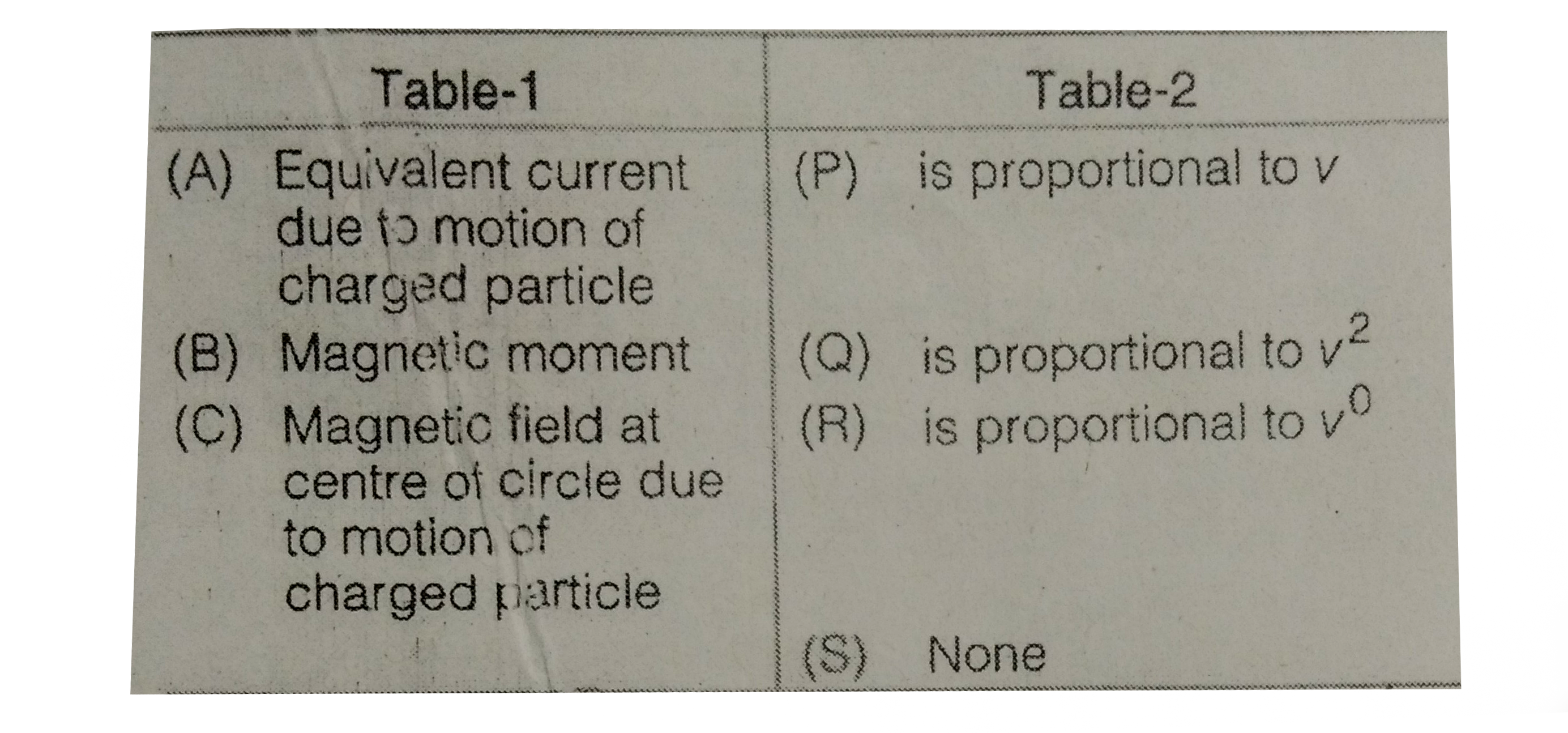A particle of mass m and having charge q is moving in a circular path of radius r in the presence of a uniform magnetic field. The particle breaks into smaller fragments X and Y of equal mass. The fragment X now has charge q3 and the fragment Y has charge 2q3. Immediately after the fragmentation, X comes to rest. The radius of the path of Y is now rY. The ratio rYr is ______________.
The correct Answer is:1.5
To solve the problem step by step, we will analyze the motion of the charged particle before and after it breaks into fragments X and Y.
Step 1: Understand the initial conditions
Initially, we have a particle of mass m and charge q moving in a circular path of radius r in a uniform magnetic field B. The centripetal force required for circular motion is provided by the magnetic force.
Step 2: Write the equation for the radius of the circular path
The magnetic force acting on the particle is given by:
F=qvB
where v is the velocity of the particle. The centripetal force required for circular motion is:
Fc=mv2r
Setting the magnetic force equal to the centripetal force, we have:
qvB=mv2r
From this, we can derive the expression for the radius r:
r=mvqB
Step 3: Analyze the fragmentation
The particle breaks into two fragments, X and Y, each of mass m2. Fragment X has a charge of q3 and fragment Y has a charge of 2q3. After fragmentation, fragment X comes to rest, which means its velocity vX=0.
Step 4: Apply conservation of momentum
Since no external forces are acting on the system, the momentum before fragmentation must equal the momentum after fragmentation. Before fragmentation, the total momentum is:
Pinitial=mv
After fragmentation, the momentum is:
Pfinal=(m2)(0)+(m2)vY=m2vY
Setting the initial momentum equal to the final momentum gives:
mv=m2vY
Solving for vY:
vY=2v
Step 5: Calculate the radius of the path of fragment Y
Now we can find the radius rY for fragment Y. The magnetic force acting on fragment Y is given by:
FY=(2q3)vYB
The centripetal force for fragment Y is:
Fc,Y=m2v2YrY
Setting the magnetic force equal to the centripetal force:
(2q3)(2v)B=m2(2v)2rY
Simplifying this:
4qvB3=2mv2rY
Rearranging gives:
rY=2mv24qvB3=3mv22qvB
Step 6: Relate rY to r
From the expression for r:
r=mvqB
We can substitute this into our expression for rY:
rY=32(mvqB)=32r
Step 7: Find the ratio rYr
Thus, we find:
rYr=32
Final Answer
The ratio rYr is 32 or 1.5.
---
Initially, we have a particle of mass m and charge q moving in a circular path of radius r in a uniform magnetic field B. The centripetal force required for circular motion is provided by the magnetic force.
The magnetic force acting on the particle is given by:
F=qvB
where v is the velocity of the particle. The centripetal force required for circular motion is:
Fc=mv2r
Setting the magnetic force equal to the centripetal force, we have:
qvB=mv2r
From this, we can derive the expression for the radius r:
r=mvqB
The particle breaks into two fragments, X and Y, each of mass m2. Fragment X has a charge of q3 and fragment Y has a charge of 2q3. After fragmentation, fragment X comes to rest, which means its velocity vX=0.
Since no external forces are acting on the system, the momentum before fragmentation must equal the momentum after fragmentation. Before fragmentation, the total momentum is:
Pinitial=mv
After fragmentation, the momentum is:
Pfinal=(m2)(0)+(m2)vY=m2vY
Setting the initial momentum equal to the final momentum gives:
mv=m2vY
Solving for vY:
vY=2v
Now we can find the radius rY for fragment Y. The magnetic force acting on fragment Y is given by:
FY=(2q3)vYB
The centripetal force for fragment Y is:
Fc,Y=m2v2YrY
Setting the magnetic force equal to the centripetal force:
(2q3)(2v)B=m2(2v)2rY
Simplifying this:
4qvB3=2mv2rY
Rearranging gives:
rY=2mv24qvB3=3mv22qvB
From the expression for r:
r=mvqB
We can substitute this into our expression for rY:
rY=32(mvqB)=32r
Thus, we find:
rYr=32
The ratio rYr is 32 or 1.5.
Similar Questions
Knowledge Check
- Question 1 - Select One
If a charged particle having charge q is moving in a circular path of radius R with a uniform speed u, what would be the magnetic field at the centre?
Aμ0qv2πR2Bμ0qv3πR2Cμ0qvπR2Dμ0qv4πR2 - Question 2 - Select One
A charged particle of mass m and charge q describes circular motion of radius r in a uniform magnetic field of strength B. The frequency of revolution is
A3Bq2πmB3Bq2πmC2πm2BqDBq2πm - Question 3 - Select One
A charged particle of mass m and charge q travels on a circular path of radius r that is perpendicular to a magnetic field B. The time takeen by the particle to complete one revolution is
A2πq2BmB2πmqBC2πmqBD2πqBm
Charged particle of charge q mass m moves in a circular path of radius r under the action of force F .The equivalent current is
View SolutionA charged particle of mass m and charge q describes circular motion of radius r in a unifrom magnetic fiels of strenght b the frequency of revolution is
View SolutionA particle of mass m and charge q is thrown in a region where uniform gravitational field and electric field are present. The path of particle:
View SolutionA particle of mass m and carrying charge −q1 is moving around a charge +q2 along a circular path of radius r. Period of revolution of the charge −q1 about +q2 is
View SolutionA charge particle (charge q ) is moving in a circle of radius R with uniform speed. v The associated magnetic moment m is given by
View Solution


